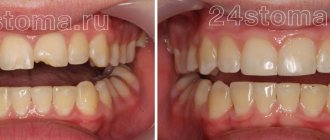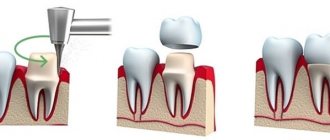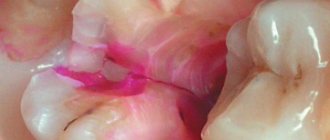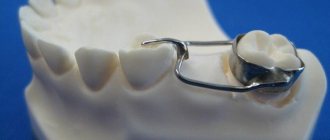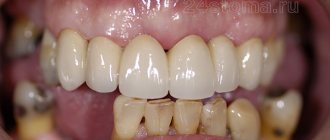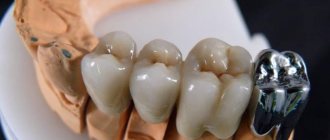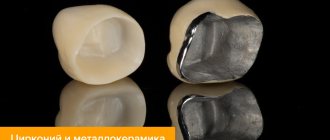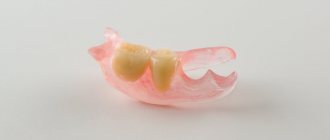18.05.2018
6558
- 1 Why are crowns needed?
- 2 Why does the crown interfere with the bite?
- 3 What to do if a temporary crown comes off?
- 4 Do I need to see a dentist?
One of the most common services provided by orthopedic dentists is the production of dental crowns. Crowns are permanent dental prostheses that can be single or fastened together. People who have undergone prosthetics often complain that the crown of the tooth interferes with chewing. Let's look at the causes and possible solutions to this problem.
What to do if a chip occurs
Modern dentistry uses several methods of metal-ceramic restoration for chips, including without removing the structure. The most common method is polishing.
It is used for small chips, or if the chip has formed in an inconspicuous place, since the shape of the crown is irretrievably lost.
The advantage of using this method is its low cost.
The method consists of treating the damaged area with a rubber brush with a special composition. The areas between the teeth are treated with finishing plates.
Repairing a chip means replacing the crown. This is the most expensive and most reliable way:
- The screwed-in structures are drilled out;
- Metal-ceramic crowns fixed with glue are subjected to hardware processing and then removed.
- After the crown is removed, a control impression is made;
- The tooth is prepared (if necessary) and processed;
- A new product is manufactured according to the layout.
Description of material
A metal-ceramic crown is made from a metal alloy and then covered with porcelain. In this case, the frame can be made of several noble metals at the same time or simply of cobalt, nickel, chromium. It is these materials that provide the structure with the necessary strength, so the tooth and jaw as a whole can function normally. The ceramic layer is responsible for aesthetics.
Replacing teeth with ceramics is considered one of the most reliable and durable options. But, as a rule, they are the ones most often exposed to chips and various damages. Therefore, you need to know what to do if a piece of a metal-ceramic crown breaks off. The fact is that ignoring this problem can destroy it completely in a short time.
This is especially true for those people who do not follow medical recommendations and consume solid foods. Such abuse often violates the integrity of the tooth: first, microcracks form on it, and later chips appear.
Restoration of metal ceramics after removal
Crown restoration is a complex job that requires professional skills. There is a serious risk of product destruction during removal. To perform this work you need special tools and devices.
If the broken fragment is preserved, it is fixed with medical glue. If there is no separated part, use the method of layer-by-layer application of the ceramic composition until the desired shape is obtained. The product is dried in a special oven using high temperature. Finally, turning and polishing are carried out. The method does not guarantee long-term use of the restored structure, even with high quality work performed.
Caring for ceramic crowns and veneers
Ceramic crowns and veneers are orthopedic structures that restore lost tooth tissue or eliminate dental discoloration (discoloration, usually in the anterior section). These structures can be installed in the area of the lateral teeth and are in the form of crowns or inlays, as well as in the area of the front teeth and can be in the form of crowns and veneers (thin overlays that are fixed to the outer surface of the teeth). They are made from various types of ceramics: feldspathic ceramics, glass ceramics, oxide ceramics.
And today there is a misconception that if you have ceramic crowns installed, you can forget about them. Not really! On the contrary, the success of treatment and prosthetics, as well as the service life of restorations, are determined by careful care both at home and in the dental clinic.
Ceramic restorations have an area of contact with tooth tissue in the subgingival region, and in this space between the gum and restoration, as well as on the surface of the crown or veneer itself, plaque can accumulate, which can lead to negative consequences.
Dental plaque is formed in the form of a biofilm - a heterogeneous bacterial mass that is organized as a solid structure (has an extracellular matrix, due to which it is tightly attached to the teeth and to orthopedic structures), which can only be removed mechanically. This biofilm leads to soft tissue inflammation, which disrupts the adherence of the gum to the surface of the restoration and contributes to the formation of subgingival dental plaque, which can disrupt the marginal fit and tightness of the crown/veneer and cause a carious process in the area of the tooth root, lead to gum recession, as well as changes in the color of the restoration, and in advanced cases, its loss.
This is what inflammation of the gums (gingivitis) looks like in the area of ceramic restorations
In this photo you can see soft plaque in the gingival area of the ceramic restoration and inflammation of the gums.
What should you not do after installing veneers?
- It is not recommended to chew nuts, crackers, seeds, etc., and you also need to get rid of the bad habit of gnawing objects (pens, pencils...), since these products can lead to microcracks with constant exposure, and subsequently to chipped restorations
- It is not recommended to use highly abrasive pastes on a regular basis, as they can scratch the ceramic surface
- eat foods that lead to a sharp change in temperature, for example, drink hot tea after ice cream, this can lead to cracks
What should you do after installing veneers?
- carry out careful care at home
- regularly carry out professional dental hygiene procedures
- Visit your dentist regularly for preventive examinations
- If a crack or chip occurs, consult your doctor immediately
- follow all recommendations
- if you engage in extreme sports where there is a risk of injury, it is recommended to use special protective mouth guards
- In case of bruxism (teeth grinding), it is also necessary to use protective mouthguards
How to whiten veneers?
This question comes up often. Let's see in what cases veneers can change color?
Ceramics itself does not change color. If the seal of the restoration is compromised, food coloring may be absorbed in this area and the border of the restoration will be stained. In this case, the restoration will most likely need to be replaced. Or, if hygienic care is not observed, plaque becomes fixed on the surface of the restoration, which can become stained and change the color of the veneers. In this situation, professional hygiene, selection of personal hygiene products and training in the correct technique for brushing teeth are necessary.
Professional hygiene of ceramic crowns and veneers
As mentioned earlier, regular professional hygiene is one of the most important criteria for the success of the treatment. This procedure is recommended to be carried out every 3-6 months based on the individual clinical situation and home hygiene skills.
How is professional hygiene of ceramic restorations carried out?
- At the first stage, the hygienist examines and assesses the hygienic status of the oral cavity.
- Then the procedure itself is carried out using gentle techniques (special hand tools, AirFlow using powders based on glycine and erythritol, superflosses, polishing strips, brushes and rubber bands with polishing pastes)
- The next step is to help the doctor select personal hygiene products and adjust home care.
How to properly brush teeth with veneers?
- Teeth should be brushed at least 2 times a day using soft-bristled toothbrushes.
- Use toothpaste or mouthwash after every meal
- use additional means such as dental floss, superfloss, dental brushes (they will help MECHANICALLY clean hard-to-reach places, which is necessary to remove biofilm - dental plaque)
- use a waterpik
What toothpastes should I use to care for ceramic crowns and veneers?
As already mentioned, highly abrasive pastes are not recommended for use, and they are not necessary for regular and proper maintenance.
It would be optimal to use pastes with complex action, based on enzymes, pastes with xylitol; they can be alternated with pastes based on herbal ingredients to care for the gums and maintain their health.
Prosthetics with ceramic crowns and veneers is an expensive and quite labor-intensive process. Therefore, it is very important to follow all recommendations and carry out careful hygienic care. This will allow you to avoid complications and enjoy a beautiful and healthy smile for a long time!
Restoration of metal ceramics in the mouth
This option is the most popular. Performed in stages:
- The problem area is thoroughly dried;
- A diamond drill is used to roughen the surface for better adhesion of the ceramics to the composite;
- The surface is cleaned, impregnated with an acidic composition, washed and dried;
- Silane is applied to the chipped area, treated with a primer, and a special mass is applied in several layers until the desired shape is obtained;
- The resulting surface is treated with an adhesive and a finishing composite material;
- Sanded and polished.
From the outside, the crown will look perfect, but there is no guarantee of long-term use of the structure after such restoration. Currently, non-destructive methods for removing crowns with the least damage have been developed - ultrasound and compressed air. However, the experience and skill of the dentist is the guarantee that the prosthesis will be safely removed and will maintain its integrity for re-installation - and without the use of high technology.
Author:
Mayorov Andrey Mikhailovich
Specialization:
orthopedic dentistry, dental prosthetics, implant installation
Main causes of damage
A ceramic crown can become damaged for various reasons. But, as dental technicians note, the most common cases of chipping are as follows:
- A man has bruxism, and the dentist who performed the prosthetics did not ask about the disease.
- The patient does not comply with the operating instructions.
- The product may chip due to a foreign body that has entered the space between the tooth and the crown.
- When manufacturing the device, the master did not take into account the composition’s ability to thermally expand.
- There are too many dental units in the bridge, so it bears a heavy load of both external and internal nature.
- The shape of the prosthesis is incorrect or poorly made, so the pressure on it from the opposite jaw row is uneven.
- The technology during firing of the structure was violated.
- The preparation was not performed correctly, the taper of the crown is incomplete, which causes severe stress within the system.
- During the restoration, an excessively thick fixing cement mixture was used.
During the operation of the crown, a chip appeared
After the recovery procedure
Forecast of dental condition
It does not matter what technique was used to restore the metal-ceramic crown. It is impossible to predict exactly how long it will last. But you can determine the approximate service life based on several factors:
- Amount of damage. If the chip was large enough or there were several of them, then such dentures will collapse quite quickly, so it is best to initially replace the old structure with a new one.
- The basis. It is very important what the crown is made of: if it is metal, then the adhesion to the composite material will be several times lower than that of ceramic products.
- Malocclusion. This pathology can provoke a new breakdown almost immediately after restoration work.
- Non-compliance with operating rules and poor dental care.
- A bridge consists of a large number of dental units.
- A leaky connection causes the structure to quickly collapse.
As dentists note, the main cause of various damages is trauma and improper care of artificial teeth. If trouble does occur, restoration measures should be started immediately, otherwise the crown may completely collapse and a new product will be required.

